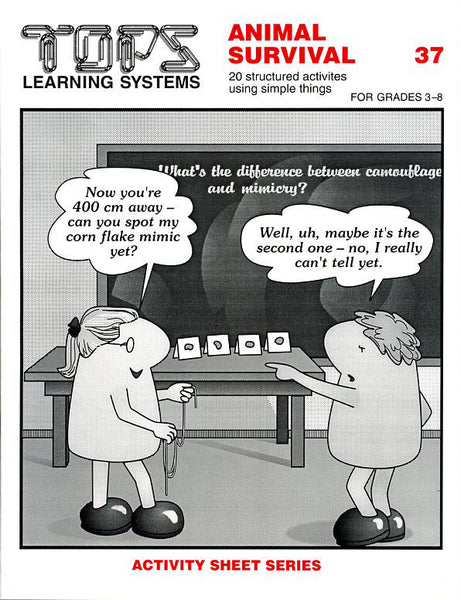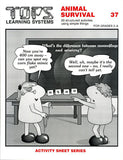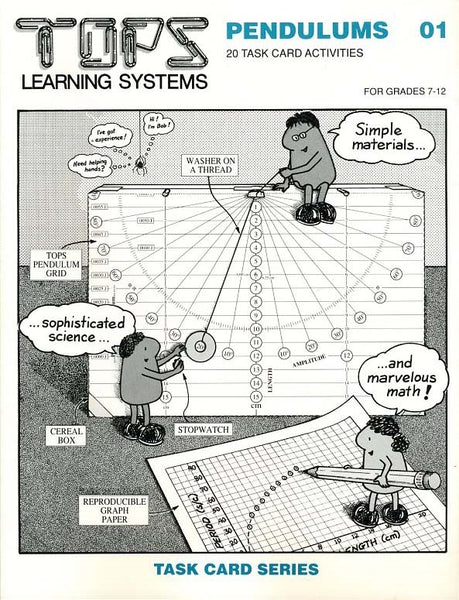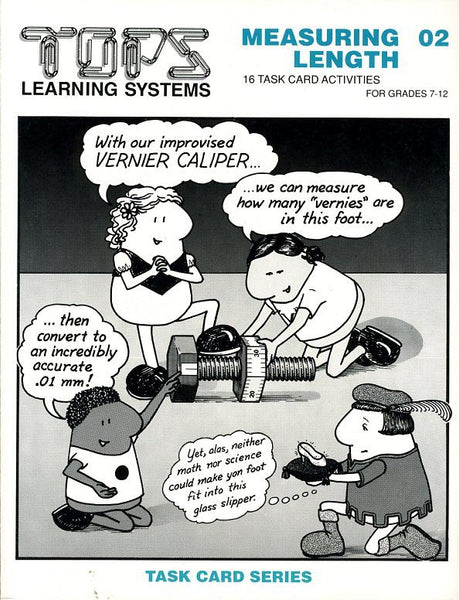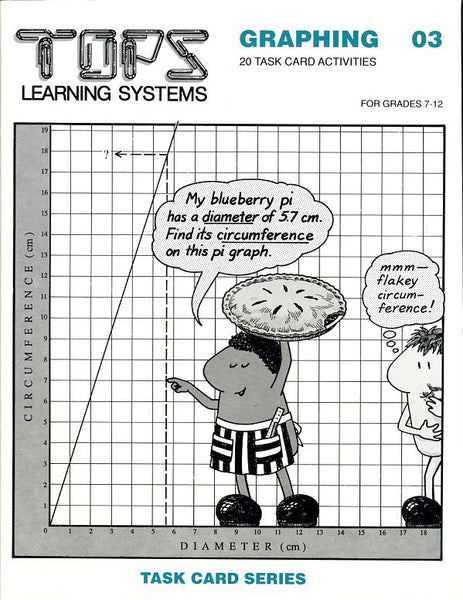#37 Animal Survival (grades 3-8)
Regular price $23.95
Soft-bound, 64 page book, 20 reproducible activity sheets, full teaching notes.
Something to charm every child in your class: physical activity, art, story-telling, imagining. Explore how creatures blend in, defend themselves, fly away, and otherwise survive in their environments. See how crafty great education can be!
More Information – click any of the tabs below to learn more about this title
Click here for a complete list of materials and convenient shopping.
Key: (1st/2nd/3rd) denote needed quantities: (1st) enough for 1 student doing all activities; (2nd) enough for 30 students working in self-paced pairs; (3rd) enough for 30 students working in pairs on the same lesson. Starred* items may be purchased below.
*1/7/10: rolls cellophane tape
1/30/30: bugs in jars (students bring from home)
1/1/1: roll of string
1/10/15: pairs of scissors
various: classroom animals (any subject that moves or makes noise is suitable). You can even ask the class to observe the teacher, observing them. (A nice way to enjoy 5 minutes of uninterrupted silence!)
*1/1/1: box aluminum foil
*1/10/15: large metal washers with 1/2 inch diameter holes
1/2/3: sets sealable jars of tempera paint in red, blue, yellow, white and black
*1/1/1: box straight plastic straws
1/30/30: plastic margarine tubs, any color OK
1/30/30: plastic margarine lids or equivalent, must be white on inside
1/1/1: sink with running water, or a bucket
1/30/30: watercolor brushes
1/7/10: bottles of paste or glue
5/200/200: index cards
1/1/1: small box corn flakes
1/1/1: cassette tape recorder
1/1/1: clock that measures seconds (or substitute wrist watches)
various: construction materials you ALREADY have on hand. These might include paper and pencil, scissors, construction paper, tape, glue, cardboard, clay, yarn, pipe cleaners, fabric scraps, rubber bands, clothespins, straight pins, bottle caps, buttons, or paper clips. Paper mache supplies may also be useful: flour, water, newspaper strips, molded over forms of crumpled paper and masking tape, balloons, chicken wire and the like.
*1/7/10: rolls cellophane tape
1/30/30: bugs in jars (students bring from home)
1/1/1: roll of string
1/10/15: pairs of scissors
various: classroom animals (any subject that moves or makes noise is suitable). You can even ask the class to observe the teacher, observing them. (A nice way to enjoy 5 minutes of uninterrupted silence!)
*1/1/1: box aluminum foil
*1/10/15: large metal washers with 1/2 inch diameter holes
1/2/3: sets sealable jars of tempera paint in red, blue, yellow, white and black
*1/1/1: box straight plastic straws
1/30/30: plastic margarine tubs, any color OK
1/30/30: plastic margarine lids or equivalent, must be white on inside
1/1/1: sink with running water, or a bucket
1/30/30: watercolor brushes
1/7/10: bottles of paste or glue
5/200/200: index cards
1/1/1: small box corn flakes
1/1/1: cassette tape recorder
1/1/1: clock that measures seconds (or substitute wrist watches)
various: construction materials you ALREADY have on hand. These might include paper and pencil, scissors, construction paper, tape, glue, cardboard, clay, yarn, pipe cleaners, fabric scraps, rubber bands, clothespins, straight pins, bottle caps, buttons, or paper clips. Paper mache supplies may also be useful: flour, water, newspaper strips, molded over forms of crumpled paper and masking tape, balloons, chicken wire and the like.
- Lesson 1: To sharpen observation and communication skills. To enable students to express themselves at higher levels of thought.
- Lesson 2: To learn to see clearly and say it well.
- Lesson 3: To observe similarities and differences between yourself and another animal.
- Lesson 4: To provide a generalized form useful for observing a diversity of animal life, both in and out of the classroom. To understand the distinction between a observation and an hypothesis.
- Lesson 5: To recall the many different ways that animals survive. To relate animal survival strategies to variations in habitat.
- Lesson 6: To appreciate how each body part helps a bird survive in its particular environment.
- Lesson 7: To study how animals survive using escape and confusion. To appreciate the rich diversity of animal adaptation within these two broad categories.
- Lesson 8: To discover how primary colors mix to form secondary colors plus brown. To introduce a foil mini-paint system useful in future painting activities.
- Lesson 9: To study tinting and shading. To learn how to mix a broader, more subtle spectrum of color.
- Lesson 10: To practice mixing and blending primary colors, plus white and black, to match any given color value.
- Lesson 11: To create 3 natural-looking environments, then paint a critter that can survive in one of them.
- Lesson 12: To experimentally determine which colors camouflage best in 3 simulated natural environments. To relate this information to animal coloration.
- Lesson 13: To camouflage paper moths so they blend into the patterns and textures of classroom surfaces.
- Lesson 14: To understand mimicry as a survival strategy. To cleverly mimic the appearance of a corn flake.
- Lesson 15: To understand how animals use shape, color and sound to warn away predators.
- Lesson 16: To understand how animals communicate using sound.
- Lesson 17: To study variations in protective coverings. To understand that adaptations have disadvantages as well as advantages.
- Lesson 18: To understand speed, endurance, and camouflage as survival techniques. To consider the trade-offs.
- Lesson 19: To design fantasy animals that survive by natural means. To review the major survival strategies presented in this book.
- Lesson 20: To summarize the survival concepts learned in this book. To communicate them in a creative story-writing activity.
No special tips at this time. Please email us with your personal experiences and suggestions that might help or inspire other teachers.
National Science Education Standards (NRC 1996)
Teachers of science...
A: ...plan an inquiry-based science program. (p. 30)
B: ...guide and facilitate learning. (p. 32)
C: ...engage in ongoing assessment of their teaching and of student learning. (p. 37)
D: ...design and manage learning environments that provide students with the time, space, and resources needed for learning science. (p. 43)
• Represent a central event or phenomenon in the natural world.
• Represent a central scientific idea and organizing principle.
• Have rich explanatory power.
• Guide fruitful investigations.
• Apply to situations and contexts common to everyday experiences.
• Can be linked to meaningful learning experiences.
• Are developmentally appropriate for students at the grade level specified.
Core Concepts/Processes: Animal adaptations are driven by natural selection. Successful survival strategies pass from generation to generation. Unsuccessful survival strategies do not.
Core Inquiries: Examine how animals survive in specific environments. Can you design a critter that hides in plain sight; that survives a class vote?
Core Content: Camouflage • Mimicry • Predators and prey • Hide, fight or flight?
Core Content: Design an animal well adapted to survives in its chosen environment: Do you hop, crawl, swim or fly? Will you claw and chew your way through life, or hide and blend in? Do you carry armor, sport quills, sting or just smell bad?
TEACHING Standards
These 20 Activity Sheets promote excellence in science teaching by these NSES criteria:Teachers of science...
A: ...plan an inquiry-based science program. (p. 30)
B: ...guide and facilitate learning. (p. 32)
C: ...engage in ongoing assessment of their teaching and of student learning. (p. 37)
D: ...design and manage learning environments that provide students with the time, space, and resources needed for learning science. (p. 43)
CONTENT Standards
These 20 Activity Sheets contain fundamental content as defined by these NSES guidelines (p. 109).• Represent a central event or phenomenon in the natural world.
• Represent a central scientific idea and organizing principle.
• Have rich explanatory power.
• Guide fruitful investigations.
• Apply to situations and contexts common to everyday experiences.
• Can be linked to meaningful learning experiences.
• Are developmentally appropriate for students at the grade level specified.
Unifying Concepts and Processes
NSES Framework: Systems, order, and organization • Evidence, models and explanation • Constancy, change, and measurement • Evolution and equilibrium • Form and functionCore Concepts/Processes: Animal adaptations are driven by natural selection. Successful survival strategies pass from generation to generation. Unsuccessful survival strategies do not.
Science as Inquiry (content standard A)
NSES Framework: Design and conduct a scientific investigation. • Use appropriate tools and techniques to gather, analyze, and interpret data. • Develop descriptions, explanations, predictions, and models using evidence. • Think critically and logically to make the relationships between evidence and explanations. • Recognize and analyze alternative explanations and predictions. • Communicate scientific procedures and explanations.Core Inquiries: Examine how animals survive in specific environments. Can you design a critter that hides in plain sight; that survives a class vote?
Life Science (content standard C)
NSES Framework: The characteristics of organisms • Organisms and environments • Structure and function in living systems • Populations and ecosystems • Diversity and adaptations of organisms • Interdependence of organisms • Behavior of organismsCore Content: Camouflage • Mimicry • Predators and prey • Hide, fight or flight?
Science and Technology (content standard E)
NSES Framework: Abilities of technological design • Understanding about science and technologyCore Content: Design an animal well adapted to survives in its chosen environment: Do you hop, crawl, swim or fly? Will you claw and chew your way through life, or hide and blend in? Do you carry armor, sport quills, sting or just smell bad?

